Facing a Formal Dinner Gracefully
In this article, you will find:
Page 2
First Course: Soup
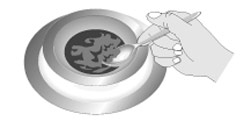
from you.
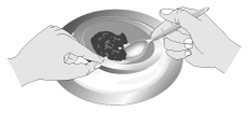
get the last bit of soup.
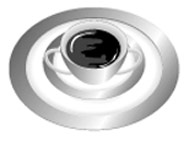
soup cup.
When eating soup, tilt the spoon away from you (dip the outer edge of the spoon, rather than the edge closest to you, into the soup first). This technique diminishes dribble danger and looks more appealing. Sip from the side (not the front) of the spoon, making no more noise than a spider. Yes, you may tilt the soup plate (often, inaccurately, called the soup bowl) away from you to access the last of the soup.
Leave your spoon on the soup plate. However, if the soup is served in a two-handled bowl or bouillon cup, leave the spoon on the underlying saucer.
Second Course: Fish
Say What?
You are halfway through your entrèe, and you realize that you're using the wrong fork
What do you say?
Nothing just then. Go ahead and finish the course with that fork. When the next course comes around, ask the server for a replacement: "May I have a new fork for this, please?"
Watch out. In fine restaurants the fish course is often served with special fish knives and forks. In that case, hold the fish fork in your left hand, prongs down, as in the continental style of dining.
Use the fish knife to break the fish and push it onto the fork. You hold the fish knife differently than you do a dinner knife because you're not actually cutting the fish but merely breaking it apart. Hold the knife between your thumb and your index and middle fingers.

If the fish is soft and boneless, you need use only the fork. In this case, leave the fish knife on the table. Hold the fork in your right hand, prongs up. The prongs can be either up or down when the fork is resting on the plate after you're finished.
Remove fish bones with your thumb and index finger and place the bones on the side of the plate.
Third Course: Sorbet
Although the serving of sorbet dates back to the Roman Empire when hosts served packed snow brought down from the mountains to clear the palates of the guests, sorbetto did not emerge until the middle of the sixteenth century in Italy. These days a sorbet is served only between the fish and meat courses, but it was once served to clear the palate of the distinctive flavors of each course and get it ready for the next.
If the sorbet is served with a garnish, go ahead and eat the mint leaves, fresh herbs, or flower petals.
Fourth Course: Meat and Fowl
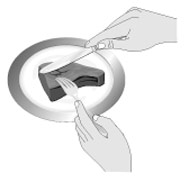
held this way.

Place your index finger
about an inch down
the handle to help you
press down firmly.

left hand, prongs down.
Here you get more serious with the use of your knife than you did during the fish course. But you should still try to use it more like a surgeon than a lumberjack would. Place your index finger about an inch down from the handle, on the back of the blade, to help you press down firmly. Hold the fork in your left hand, prongs down. Spear the meat and hold it firmly in place with the fork while you cut. Only cut enough food for each mouthful.
It's okay to put a small amount of potatoes and vegetables on the fork along with the meat.
Fifth Course: Salad
As with the fish course, you will use the salad fork and knife for this course, leaving the knife on the table if you don't need to cut anything. If cheese is served with the salad, place a small portion of cheese on your salad plate together with crackers or bread. Use the salad knife to put cheese on the crackers or bread.
Sixth Course: Dessert
When dessert is served with both fork and spoon, the fork is the pusher and the spoon is used for eating. Hold the fork in your left hand, tines down, and push the dessert onto the spoon in your right hand. Pie or cake requires only a fork. Ice cream and pudding require only a spoon. Leave the other utensil on the table.
Seventh Course: Coffee
Be careful not to overload your beverage with cream and sugar. Avoid swirling your coffee around too much, making a splash and puddle on your saucer. Don't slurp, but sip gently. If your coffee is too hot, let it sit for a while—don't blow on it. Finally, don't leave your spoon in the cup. Place it on your saucer.
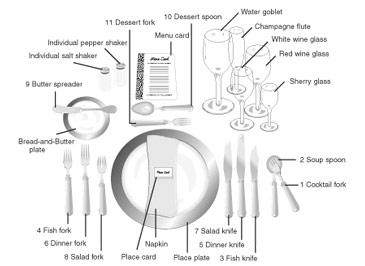
Manners at Mickey Dee's
At the other end of the spectrum, the fast-food eatery, the company lunchroom, or eating at your desk are venues about as informal as it gets. But informal does not mean sloppy. These scenarios never will replace the traditional meal; yet, they are clearly a part of life. here are some key points for handling them with grace:
- Watch that smell. Whether we are in a cubicle or on an airplane, it's rude to impose our cuisine on anybody else. High-odor foods such a fish, onions, and some lunch meats are offensive at best.
- use a knife and fork even if the food doesn't strictly dictate that. For example, a drippy chicken salad sandwich is more easily managed by eating the filling with a fork until it becomes more manageable. Ditto for pizza.
- Keep your playing field clean. those little packets of mustard, ketchup, sugar, and so on, are best hidden under your plate or immediately put into the bag the food came in. Nobody wants to feel they're next to someone who is starting a personal compost heap.
- Watch that sound. make sure you chew with your mouth closed, and don't slurp. Listening to your lunch goes a long way in killing an neighbor's appetite.
Although dining circumstances vary, you can handle them with more confidence by remembering the basics. Approach the experience with a positive attitude and a cheerful demeanor. Keep pace with the others. Watch your posture. Smile. When in doubt, do what your host does, or pick out the classiest person at the table and copy him or her. In other words: Dine among others as you would have them dine among you.